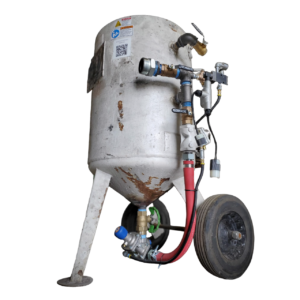KNOCK-OFF VALVES: WHY WE DON’T SELL THEM
At BlastOne, we often get asked why we prefer Schmidt blast pots and valves, and not the more affordable knock-offs. The answer is simple: we believe in providing products that last, perform reliably, and offer true value to our customers. Let us share a real-life example that highlights the difference between genuine quality and cheaper alternatives.
A tank blaster from Tennessee recently opted for a competitor’s blast pot instead of the Schmidt pot we quoted, simply because it was slightly cheaper. Initially, the knock-off pot seemed to work just fine—until the following Monday when he discovered that his abrasive metering valve had jammed with grit after just one weekend of use. He was understandably frustrated, realizing too late that he had compromised on quality. This is a scenario we’ve seen too often, which is why we’re committed to offering only the best products like the Schmidt TeraValve.
Some manufacturers may profit from selling replacement parts and rebuild kits for these inferior products, but at BlastOne, our goal is to build lasting relationships with our customers by providing them with equipment that minimizes downtime and maximizes efficiency.
Here’s why Schmidt TeraValves stand out:
- Longevity: Schmidt TeraValves typically last 12 months with regular use before needing a rebuild, outlasting knock-off valves by two to three times.
- Reliability: Knock-off valves, due to their lower manufacturing standards and outdated designs, often need replacing within 1-2 months.
- Efficiency: Substandard valves often lose their adjustment during blasting, leading to excessive abrasive use. In contrast, the TeraValve’s robust gasket ensures the valve settings stay secure, preventing unnecessary waste.
- Cost Savings: Over time, using a Schmidt TeraValve can save you an average of 100 lbs. of abrasive per hour compared to knock-off valves.
At BlastOne, we believe that quality and reliability shouldn’t be compromised for short-term savings. The cost of downtime and frequent part replacements quickly outweighs the initial savings of cheaper equipment.
 My Account
My Account




